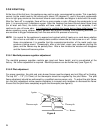
21
3.3.6 Initial firing
At the time of the first burn, the appliance may emit an odor, accompanied by smoke. This is perfectly
normal. As the metal heats to the critical point (about 375 degrees F), part of the paint components
turns to light gray smoke as the dormant silicone resin activates and begins to bond with the metal.
After the “burn-off” is complete, there will be no more smoke or odor. Although the smoke/odor is not
toxic, it is annoying and it displaces oxygen. After the fireplace has been burned about three times
(for at least one hour), the entire surface will have cured. If the process is not complete, it will
continue to give off some odor. It is important to ventilate the house during these initial burns. We
advise removing young children, elderly persons and anyone suffering from breathing disorders (or
are sensitive to oxygen imbalances) from the area while this process is occurring.
NOTE: It is normal for the appliance to expand and contract while it heats up or cools down whether
this is from a cold start or a steady-state condition where the fan has come on or off. Under
these circumstances it is possible that the expansion/contraction of the metal parts may
produce a ticking sound. Occasionally, after a cold start, vapor may condense and fog the
glass, and the flames may be partially blue. After a few minutes the moisture will disappear
and the flames will become yellow.
3.3.6.1 Manifold pressure regulator adjustment
The manifold pressure regulator controls gas input and flame height, and is pre-adjusted at the
factory. No further adjustment is required. Manifold pressure can be verified only (see Figure 2).
3.3.6.2 Pilot adjustment
For proper operation, the pilot and main burner flames must be steady and not lifting off or floating.
The top 3/8” – 1/2” (10-13mm) of the thermopile should be engulfed by the pilot flame. The pilot
flame adjustment should be performed by a qualified service person only. To adjust the pilot flame,
turn the pilot adjustment screw counter-clockwise to increase and clockwise to decrease the flame.
Ensure that the pilot flame completely engulfs the thermopile (see figure 8).
Figure 8
Igniter
Burner
Thermopile Thermocouple


















